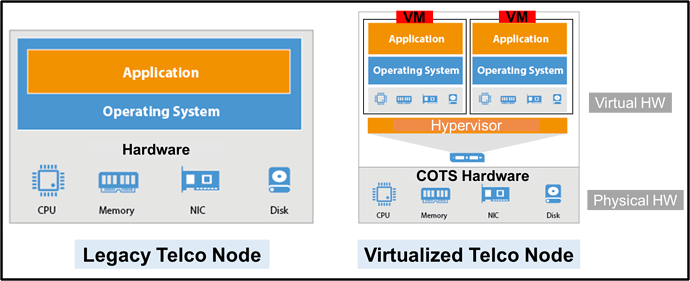-
My friend: Hi Ibrahim, I have a question for you.
- Me: Go ahead, please.
-
My friend: I was wondering why do we need to virtualize the mobile networks? As many MNOs already did, starting with core network.
- Me: This is a very good question and to answer it, let’s go back in time when core network elements such as S-GW, P-GW, MME, or any other core element are installed in the mobile networks and each element was a black box that deliver only one function. So, for example, the equipment that provides the MME functionality is delivering only the MME functions and can’t be used for any other core functionality. Which means one HW delivers only one function, and so no flexibility. Another bad thing is that these pieces of core equipment were designed to deliver the peak load, around 95%, that can happen in specific and few times during the year, while most of the year, the load of the core elements is low, maybe around 25%, so that means under-utilized HW. Also, this HW is running all the time which consumes energy, so energy consumption is high which costs money as well.
-
My friend: But how virtualization will help to solve all these issues?
- Me: Simply, virtualization will disaggregate the HW from the SW by breaking down any telco node into three parts, the 1st one is the COTS HW which is a low-cost HW that is highly available and can be got from any company such as Dell, HP, etc. compared with the high-cost purpose-built HW from any telco vendor such as Ericsson, Nokia, etc. The 2nd part is the Hypervisor which is similar to OS (Operating System), but it is not an OS and used to divide all the resources in the COTS HW such as CPU, RAM, NIC, Storage, etc. between the VMs (Virtual Machines) which is the 3rd part. So, each VM will be isolated from other VMs with its own virtual resources and so multiple applications can be installed at multiple VMs over the same COTS HW which means our HW is better utilized now. Moreover, the resources assigned to each VM can be increased or decreased based on the load that is carried by these VMs which means more flexibility which was not available before in legacy solutions.
-
My friend: is there any extra advantage for virtualization?
- Me: Yes, creating a VM will take a few seconds unlike the physical machines which will take days to be ready which means increased service agility to support new faster service rollouts. Also, faster innovation due to a software-governed network that eliminates the need for HW changes. This approach precludes any vendor lock-in, in both the HW and the SW domain. Furthermore, we can commission or decommission services within minutes. BTW, note that this concept can be applied to both core network and RAN as well.
-
My friend: Thank you very much, you made it very clear.
- Me: You are most welcome.
LinkedIn: ![]()
